Key takeaways:
- Accessibility is essential for inclusivity in events, requiring thoughtful planning to accommodate diverse needs beyond regulations.
- Venue evaluation should involve in-person visits, consideration of layout, and input from individuals with disabilities to identify practical accessibility challenges.
- Technology, such as mapping software and checklists, can enhance the assessment process by identifying barriers and ensuring all accessibility features are functional.
- Involving a diverse site visit team helps uncover potential issues that may be overlooked, reinforcing the importance of considering various perspectives in planning.
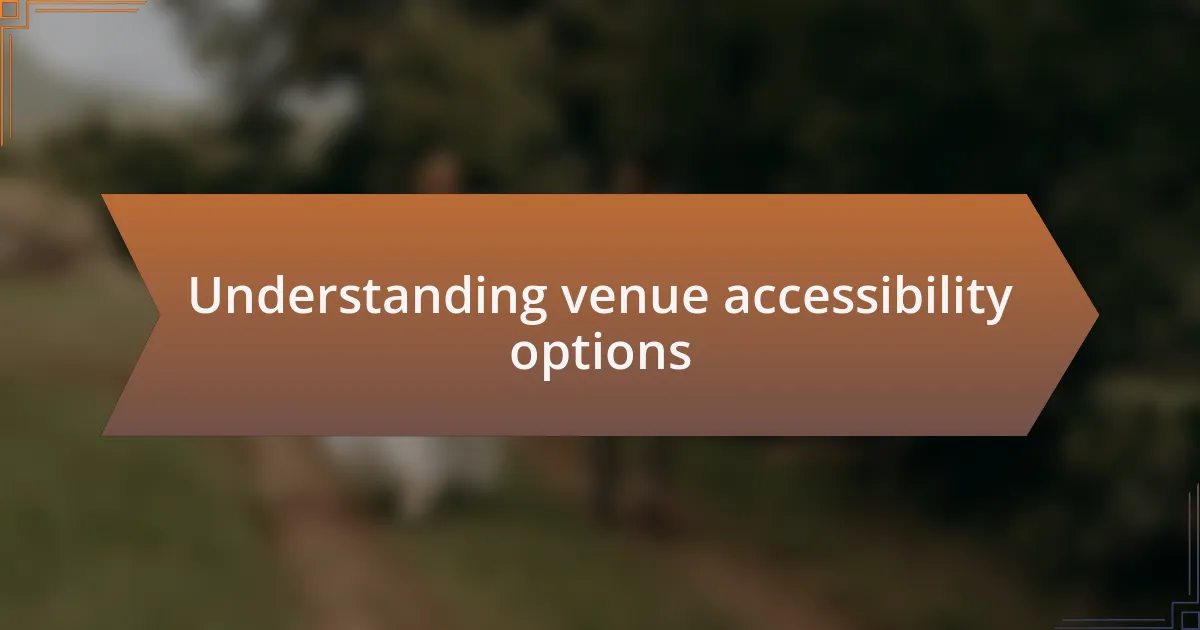
Understanding venue accessibility options
When I think about venue accessibility options, I realize how crucial they are for creating an inclusive environment. Have you ever attended an event where you felt out of place simply because the venue didn’t cater to your needs? I have, and it left me contemplating how often accessibility is overlooked in event planning.
Understanding the various aspects of accessibility is like peeling an onion—there are layers. I remember visiting a venue that had ramps but ended up being a maze for someone using a wheelchair. It made me appreciate the importance of not just having features like ramps, but also ensuring that they lead to key areas such as seating and restrooms without unnecessary obstacles.
Moreover, it’s essential to consider different disabilities. One time, a friend who is hard of hearing struggled at an event because there were no sign language interpreters available. This made me realize that accessibility isn’t one-size-fits-all; it requires thoughtful planning tailored to meet diverse needs. Wouldn’t it be wonderful if every event organizer recognized this and strived to accommodate everyone?
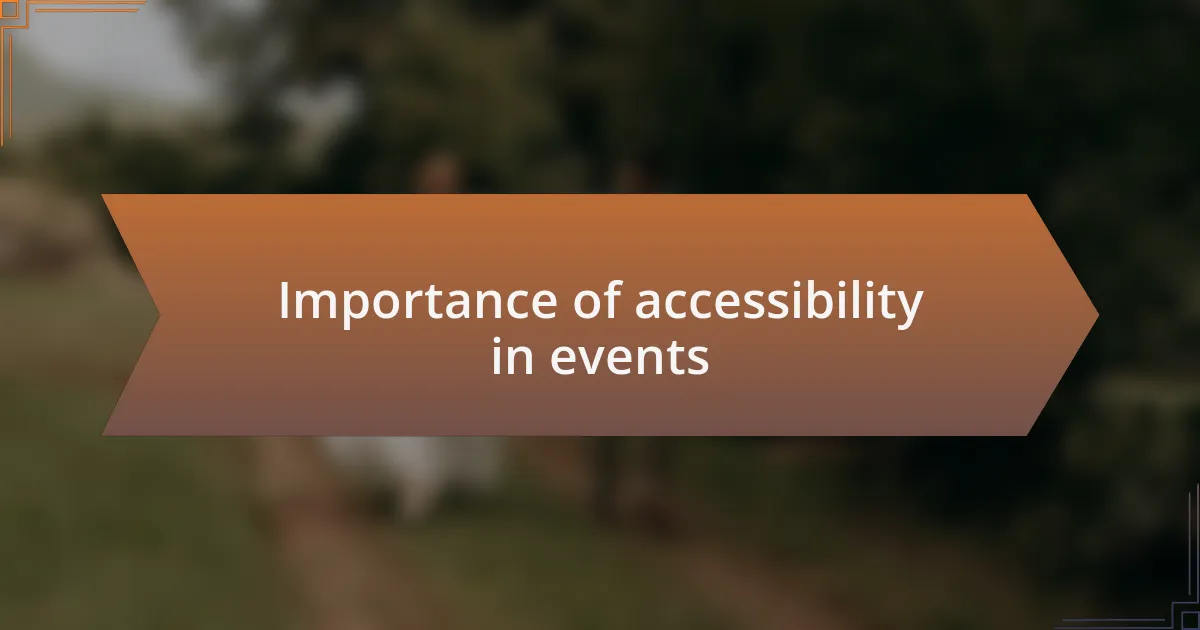
Importance of accessibility in events
Accessibility in events is not just about compliance with regulations; it’s about compassion and respect for every attendee. I remember attending a community festival where a participant in a wheelchair was struggling to access the main stage. Witnessing their frustration emphasized to me that true accessibility fosters a sense of belonging and enjoyment, which every participant deserves.
Consider how it feels to be isolated in a crowd because of a lack of accessibility. Once, I attended a networking event where the seating arrangements made it impossible for my colleague, who uses a mobility aid, to participate fully. This made me realize that when we neglect accessibility, we inadvertently create barriers that can diminish the overall experience for everyone involved. If we want to build vibrant communities, we must ensure that everyone can engage and contribute.
Moreover, providing accessibility options can enhance the event’s reach and reputation. I’ve seen events flourish when they prioritized inclusive features, attracting a more diverse audience. Isn’t it astonishing how making small adjustments can lead to a significant impact on participation? It’s clear that when accessibility is woven into the event planning process, it transforms not just the event, but also the shared experiences of all attendees.
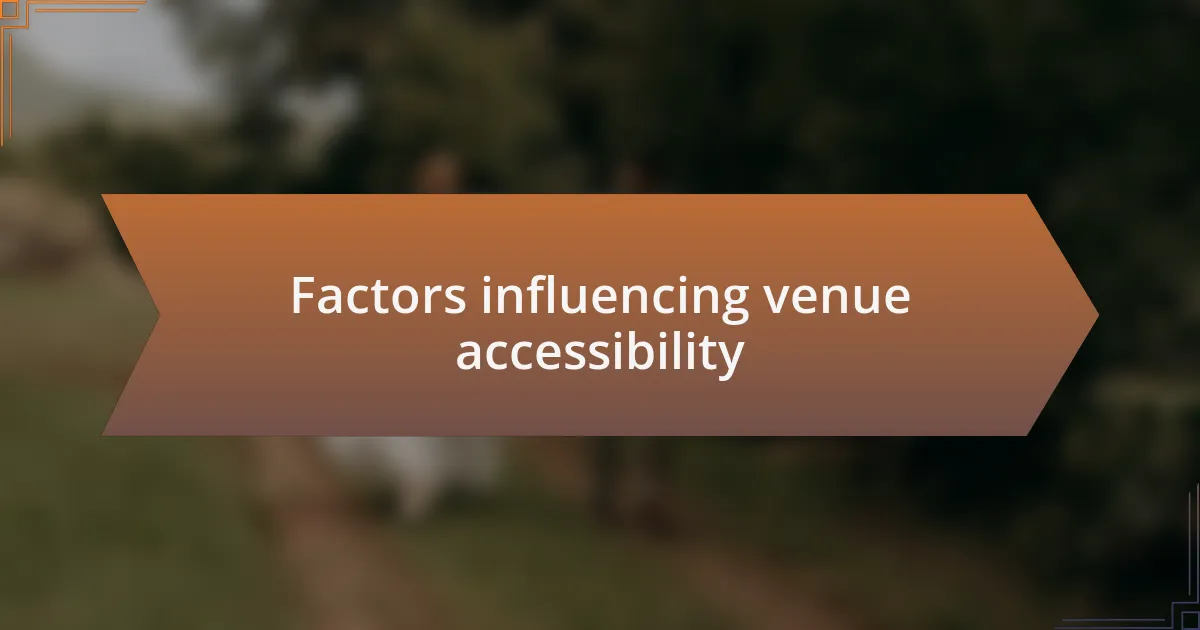
Factors influencing venue accessibility
Assessing venue accessibility involves several key factors, starting with location. I remember scouting a venue in a bustling downtown area that, while visually appealing, turned out to be a logistical nightmare for attendees with mobility challenges. Finding a spot that balances aesthetic appeal and practical access is vital. Are we willing to sacrifice the experience of some attendees for a pretty backdrop?
Transportation options are another crucial consideration. At a large conference I attended, I saw many people struggle to navigate public transit routes that weren’t well-marked or equipped for accessibility. This experience highlighted to me how essential it is to evaluate not just the venue itself, but also how attendees will arrive there. Have you ever had to change your plans because of limited options?
Finally, the actual layout of the venue plays a significant role in accessibility. I recall a gala where the seating arrangement lacked adequate space for maneuvering wheelchairs. This made it evident that even a venue labeled “accessible” can fall short without proper consideration of its design. Does this mean we should always prioritize open spaces and clear pathways? Absolutely! Ensuring that every inch of the venue promotes inclusivity can truly enhance the experience for everyone involved.
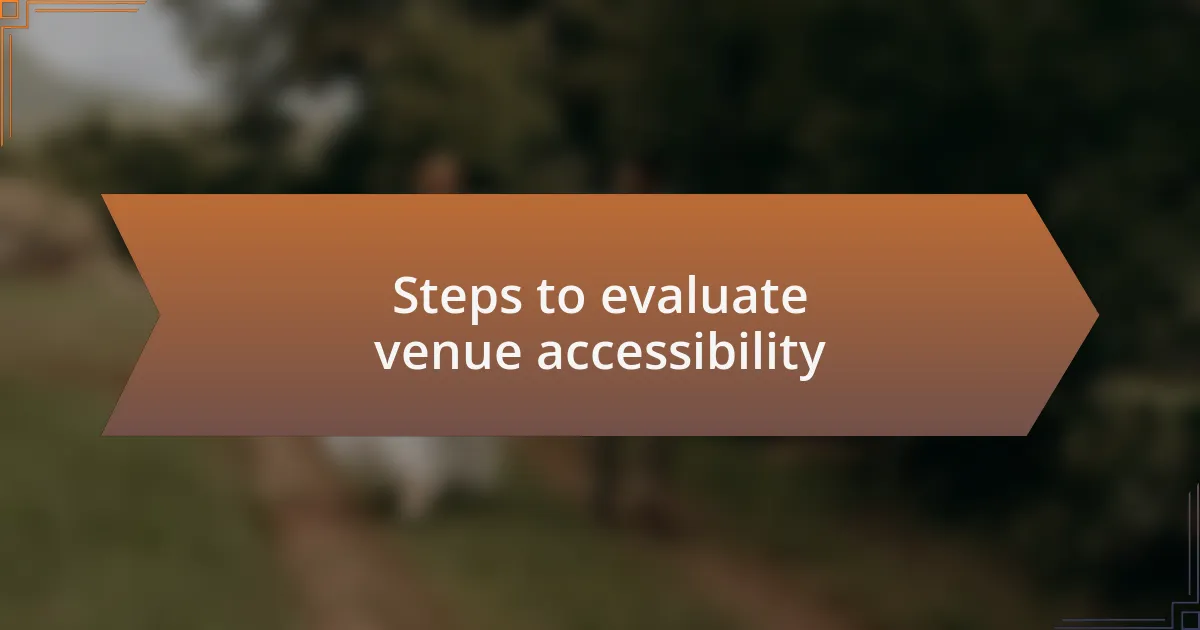
Steps to evaluate venue accessibility
When it comes to evaluating venue accessibility, I find that one of the first steps is to conduct a comprehensive site visit. During my last venue assessment, I wandered through each entrance and exit, taking note of any potential barriers. It was eye-opening to see how misleading floor plans can be; what looks accessible on paper might still present real challenges in person. Have you ever walked into a space that seemed perfect but felt claustrophobic once inside?
Next, I like to assess the amenities available for attendees with disabilities. I recall a situation where a venue boasted accessible restrooms, but upon arrival, I discovered they were frequently out of order. This experience reinforced my belief that venues should not only claim to be accessible but must also actively maintain those features. How often do we overlook the importance of functionality over flashy promises?
Lastly, I advocate for gathering feedback from individuals who will directly use the venue. I once worked alongside an organization planning an event for people with disabilities, and they eagerly shared their thoughts on what worked and what didn’t at previous venues. Listening to firsthand experiences not only shaped my recommendations but also reminded me how crucial it is to involve diverse voices in the planning process. Are we truly doing our best if we don’t hear from those who matter most?
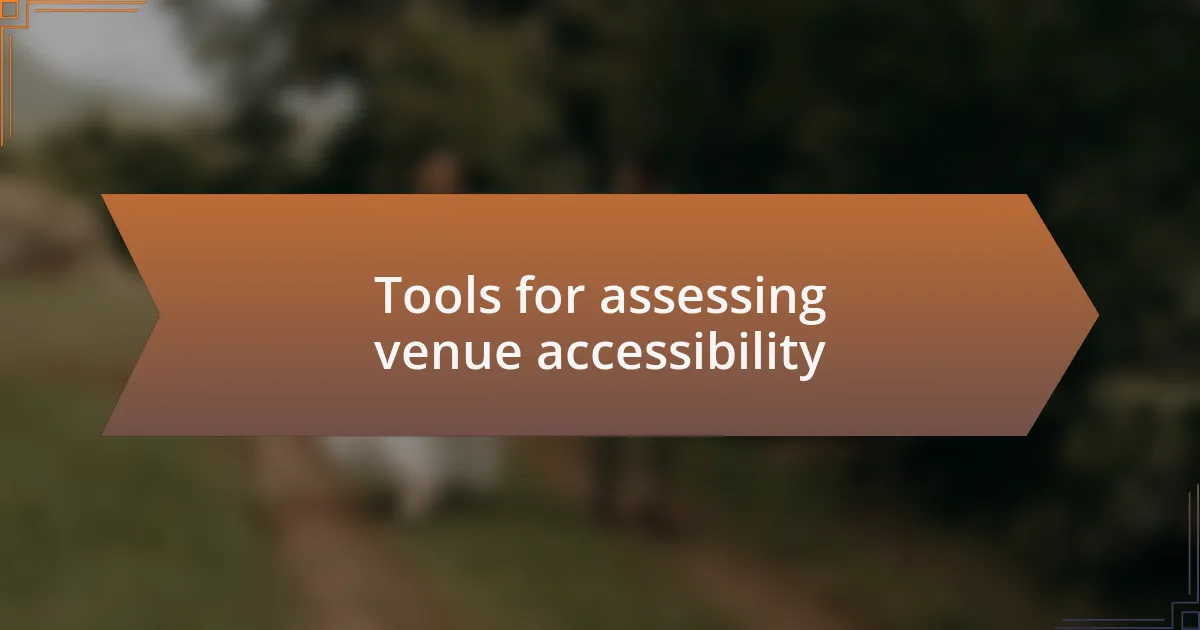
Tools for assessing venue accessibility
When it comes to tools for assessing venue accessibility, I’ve found that technology can be a game-changer. A notable tool I like to utilize is accessibility mapping software, which lets me visualize routes and identify barriers that aren’t always apparent on paper. The first time I used it, I discovered hidden stairs and narrow doorways that would have been a nightmare for attendees with mobility challenges—it’s remarkable how digital tools can enhance our real-world understanding, don’t you think?
Another resource that has proven invaluable is the use of accessibility checklists. I created my own based on best practices, which includes everything from bathroom facilities to signage clarity. It was during one event planning session that I realized my checklist wasn’t just a formality; it became a lifeline for ensuring nothing was overlooked. How reassuring is it to have a structured way to measure what truly matters to our guests?
Finally, I often reach out to organizations specializing in disability advocacy. Their insights are instrumental in assessing venue accessibility. One time, a representative took me on a tour of a facility and pointed out subtle details I could easily have missed, like the height of a podium or the maintenance of ramps. It was a humbling reminder that expert opinions and lived experiences offer value that no software or checklist can replicate. Are we really considering all perspectives if we neglect to consult those who live this reality daily?
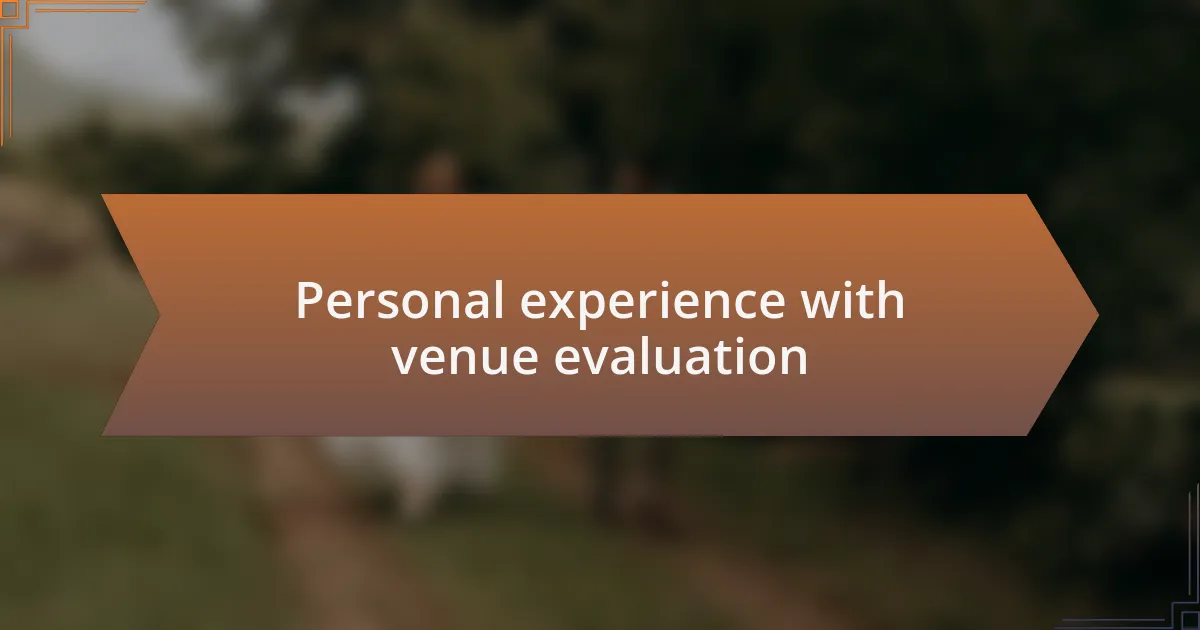
Personal experience with venue evaluation
When I first began evaluating venues, I relied heavily on my instincts and checklists. However, there was one instance that caught me off guard: I arrived at a venue ready to check boxes, only to find the main entrance blocked off by construction. It was a frustrating moment that underscored the importance of an in-person visit—sometimes, even the best planning can fail if you don’t assess what’s right in front of you.
I remember another time I was leading a group through potential venues. One participant shared her struggles with navigating different spaces, and it made me realize how crucial it is to listen to firsthand experiences. The empathy that blossomed in that moment shifted my perspective entirely; it wasn’t just about meeting accessibility standards but actively engaging with the needs of everyone involved.
During a recent assessment, I discovered a venue that seemed perfect on paper but felt claustrophobic in reality. It reminded me how essential it is to trust my gut feelings during evaluations. Sometimes, the atmosphere of a space can profoundly impact the experience—what looks good in images can fall flat without the right ambience. Isn’t it fascinating how our senses guide us in making the best choices?

Recommendations for accessible venue selection
When evaluating venues, I always emphasize the importance of clear signage and accessible routes. On one occasion, a venue had accessible entrances but lacked proper directions, leaving many attendees confused. It made me realize that the experience begins before guests even walk through the door. How can we expect people to feel welcomed if they can’t easily navigate their way in?
I also advocate for assembling a site visit team that includes individuals with diverse accessibility needs. In one experience, inviting a friend who uses a wheelchair opened my eyes to potential barriers I hadn’t considered. Hearing her insights about width requirements and surface textures highlighted aspects of accessibility that often go unnoticed. Isn’t it essential to make decisions with the voices of those directly affected by them?
Accessibility features should not just comply with regulations; they should reflect a commitment to inclusivity. I once visited a venue that boasted ramps and elevators but neglected the wheelchair-accessible restrooms. It felt disheartening because it showed a lack of foresight. When selecting a venue, it’s vital to ensure that every aspect of the space genuinely accommodates everyone’s needs, reinforcing the idea that every detail counts in crafting an inclusive experience.